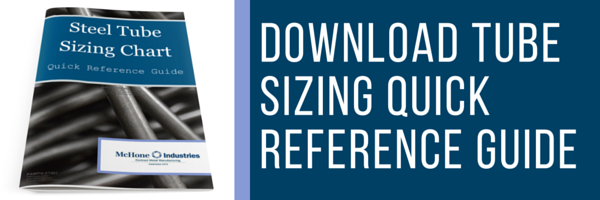
Are you trying to decide between metal tubing and plastic tubing for your project? Like anything else, the best material for you depends on your specific application and needs. In some cases, metal tubing will be best; in others, plastic will come out on top.
Here are the major differences, pros and cons, and best applications for metal and plastic tubing.
Differences Between Metal Tubing & Plastic Tubing
When putting metal and plastic tubing against one another, there are three key factors to evaluate:
- Strength and durability
- Appearance
- Environmental impact
Strength and Durability for High-Stress Applications
Metal tubing is, overall, much stronger than plastic tubing - especially in high-stress applications such as construction and infrastructure.
Because metal tubing is stronger and more durable than its plastic counterparts, less material is required to produce tubing of equivalent strength. Further, a smaller amount of metal tubing can handle larger amounts of stress, pressure, temperature, and fluid volume.
Appearance
Metal is inarguably the more attractive material between the two. If you're concerned about aesthetics for your project, metal will provide a shiny, sleek, and modern appearance for your product.
Appearance can be especially important in automobiles, structural and architectural applications, and many retail products.
Eco-Friendly
Especially in the case of tubular steel, metal tubing is 100% recyclable and has little to no impact on the environment. Once it's reached the end of its lifespan, metal tubing can be melted down for a number of uses - sheet metal, tubing, bars, and more.
Plastic tubing is not recyclable, creates harmful chemicals as it degrades (which are difficult to contain, and the pollution spreads easily through water), and causes damage to the environment and human population.
Plastic is especially infamous for its effects on male fertility.
Pros & Cons
As both plastic and metal tubes are distinctly different, each has its benefits and drawbacks.
Metal Tubing
Pros: Environmentally friendly, great for high-stress applications, sleek appearance for aesthetically focused projects.
Cons: Can be more expensive depending on volume, material, and sizing.
Plastic Tubing
Pros: Flexible, lightweight, relatively low cost.
Cons: Relatively weak, not recyclable, shorter lifespan, can't handle high-stress applications.
Metal Tubing Vs. Plastic Tubing: Applications
Metal and plastic tubing are in products all around you. Depending on the product, sometimes they're used interchangeably.
Metal Tubing
Metal tubing is best for high-stress, high-pressure, extreme temperature applications. However, it can also be used in day-to-day retail products and devices such as tool handles, lawn and garden components, and shopping carts.
Metal tubing is often used in:
- Vehicles and transportation
- HVAC
- Construction
- Infrastructure
- High-pressure fluid transport
- Medical devices, structures, and appliances
- Solar and energy products
Plastic Tubing
Plastic tubing is best for applications that require flexible tubing, or tubing that needs to bend and reshape freely.
- Hoses
- Food and beverage transport
- Fuel lines
- Pump feeds
- Refrigeration/HVAC components
- Gauges
- Spray systems
- Dispensers
Metal Tubing or Plastic?
Again, your choice will depend on your project. Hopefully this blog post has shed some light on the best material for you!
If you have any questions about metal tubing, products, or applications, feel free to contact us for more info.


